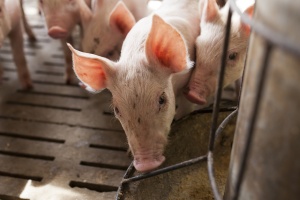Cow’s Milk: Antibiotic (and Worry) Free!
Can you recall the last time you purchased cow’s milk? You may have made your purchase decision based on brand, fat percentage, or sell by date. You also may have noticed certain stamps or labels used by companies that claim their product is “antibiotic free.” Did this affect your purchase decision? If so, you are not alone! But where does this idea of antibiotics in cow’s milk come from? Dietetic interns, Brittany, Rachel, Sarah and Savannah from Northern Illinois University had the privilege of visiting Mitchell Dairy Farm in Winnebago, Illinois to learn exactly where their milk is coming from.
The 2015 Dietary Guidelines published by the United States Department of Agriculture recognizes dairy products as key contributors of the nutrients calcium, phosphorus, vitamin A, vitamin D, riboflavin, vitamin b12, potassium, zinc, choline, magnesium, selenium, and protein to the American diet. Because dairy exhibits so many nutritional benefits in a balanced diet, the recommended amounts of servings of dairy per day range from 2-3 cups depending on age. Adolescents 2-3 years old should consume 2 servings per day, adolescents 4-8 years old should consume 2.5 servings per day, and adolescent 9 years and older as well as adults should consume 3 servings of dairy per day to meet the recommended amounts. Fat-free or low-fat (1%) milk, yogurts, or cheese are lower fat options that provide the same nutrients but less fat than whole milk and yogurt or full fat cheeses. Incorporating fat-free or low-fat dairy options more than higher fat dairy is recommended.
Cow’s milk and dairy products are rich sources of so many vitamins and minerals as well as a good source of protein, but what about antibiotics? Well you do not have to worry about that any longer!
No milk with antibiotics is sold for human consumption. In fact, according to Mitchell Dairy Farms, it is illegal. The “antibiotic free” label you see on your milk is really just a marketing ploy to relieve consumers due to promoted misinformation. Contrary to popular belief, antibiotics are only used to treat a cow that is sick, much like how we receive antibiotics only when we have a bacterial infection. The sick cow is visited by a veterinarian and given an antibiotic appropriate for the specific bacterial infection. Dairy farmers follow strict testing protocol that includes dumping all milk with any traces of antibiotics. Every antibiotic that is used has a labeled milk withdrawal time that is set by the Food and Drug Administration (FDA), which states how long that cow’s milk must be kept away from food supply. After the withdrawal time is complete, a test is performed on the milk to ensure that no antibiotic residue remains in the end product. Farmers can perform this test themselves, but this test is also performed at the processing plant before the milk is ever unloaded from the semi. If milk sent for distribution is found to have any antibiotics, it is dumped, resulting in thousands of dollars lost for farmers. Therefore, milk is tested multiple times before it hits the shelves, ensuring the milk we pour over our cereal is antibiotic free!
Milk and dairy products are an affordable and nutrient dense food that offers a multitude of health benefits. The Marketing claim of “antibiotic” free is a method of food bullying that allows companies to bring in more money while also scaring consumers away from this valuable food. American dairy farming is a hard-working, diligent and detail oriented profession that provides a nutritious and affordable staple to our households.
Savannah Peters, Rachel Narofsky, Brittany Rees, Sarah Lackowski
Northern Illinois University Dietetic Interns










0 Comments